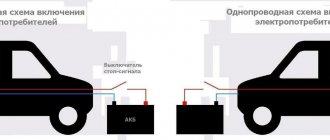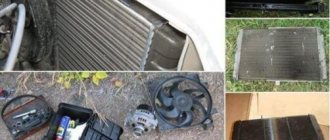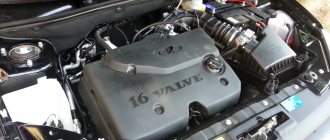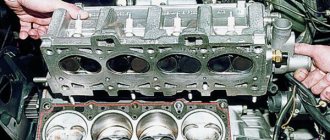- home
- car battery
- …
This problem can manifest itself both in winter (cold) and summer (warm) periods of time, and it practically does not depend in any way on winter starts. What happens when starting or when the engine is already running, one of the battery terminals begins to heat up wildly, if you drop water on it, it will begin to steam. Why does this happen and how to deal with it, let's figure it out...
At the very beginning, I want to say that this malfunction can occur on different cars (the make and model does not matter), and often this can be the reason for the battery failure, and in a very short period of time.
Why does the battery fail?
Just a couple of lines about why the battery may fail:
- Warming up the terminal, and then heating the current output and after the entire battery (including plate packs), provokes the evaporation of distilled water from the electrolyte. As the capacity drops, the plates may crumble and in general, the battery will not last long in this mode.
- If the current lead heats up, it can melt the plastic of the housing that is located next to it. Microcracks appear, through which water from the electrolyte begins to evaporate, and sulfuric acid often gets onto the terminal. Strong “oxides” form on it, which further interfere with the operation of the battery, undercharging and poor starting are possible
- YES, and the most common reason is that the case can melt from high temperatures. This is rare, but it happens; you can no longer use such a power source.
BUT this is not the only danger; a fire is not far away.
Briefly about terminals
The connection of the contact group of automotive electrical equipment with the battery terminals is made using metal terminals.
In accordance with international standards, the following types are produced:
- Type A. Designed for use in a European-made power supply. The leads are a truncated cone; the positive and negative current leads have a diameter of 19.5 mm and 17.9 mm, respectively.
- Type B. This is a contact for a vehicle power supply with element diameters of 11.1 mm for the negative and 12.7 mm for the positive terminal. Used in Japanese-made technology.
- Types F and G. Designed for connecting the on-board network cable to the battery using screws and bolts.
- Types T and E. They are used for power supplies made in Russia; they can also be used in European technology.
Batteries with terminals of type A and B have become widespread; many manufacturers produce equipment of the corresponding design. The terminals are metal clamps that are designed to ensure contact between the on-board network and the battery. To avoid poor contact, it is necessary to tighten the parts using bolts or screws passed through the body and secured with a nut on the other side.
Why does the terminal get hot?
Quite large currents flow from the battery to the starter, and then from the generator back to the battery. Just think - starting currents, in winter, can reach up to 600A. If you install a thin wire, it will simply not be able to cope with such a load and will melt before your eyes. This is why the wires are so thick and solid, all because they are designed to carry high loads.
Let's watch a short video.
There are not many reasons and they are all banal:
- The problem is in the terminal itself . There is poor contact between the wire and the fastener, sometimes it comes straight from the factory, a manufacturing defect (for example, the hole in the terminal is 10 mm, and the wire is 8 mm).
- It happens over time that water can get into this place or oxides can form. The bottom line is that wires and fasteners are often made of different metals, the potential difference sooner or later leads to oxidation of the contact point and the current conductivity drops significantly.
- Oxides between the terminal and the current terminal. This also happens, but rarely, if the contact is bad, then the current must pass through a very narrow point of contact. Warming up can come from here.
- The wire . Sometimes the wire itself suffers, say, from an accidental break in the middle that is not visible to the eye. That is, several threads were broken, and the load that he could bear decreased.
- Poor contact with body . Often it is the negative cable and after the terminal that get hot. This is because it is bolted to the car body, and then both the starter and the generator are “powered” from the body. On modern foreign cars, the negative cable is quite short (on some cars it is attached to the engine block). So, the cable will heat up, but you will mistakenly think that it is the terminal (although with such a malfunction, the braiding of the wire itself will most likely begin to recover).
The positive terminal can only heat up from poor contact or, again, from oxides that have formed between the mount and the current terminal.
Types and materials
The materials for the terminals, as well as the design options, may vary. Basic materials for making terminals:
Lead, as you know, is a soft material, has a lower melting point and worse conductivity compared to the same copper. What's the matter? The point is safety. If a short circuit occurs, fusible lead will turn into a liquid state faster than other materials. In addition, lead is resistant to battery acid, which can oxidize other terminals.
Important! The most preferred material is lead.
The most common is the European terminal standard, but there are also Asian, American, and many other forms that are marked but do not have a name. All varieties are marked with letters of the Latin alphabet. Let's look at them in more detail.
Most often, cone contacts are used for car batteries:
- Terminal type cone “A”. Plus diameter - 19.5 mm; negative with a diameter of 17.9 mm.
- “B” cone type batteries. The current contact with a minus sign has a diameter of 11.1 mm, and with a plus sign ─ 12.7 mm. Also called Asian standard.
Not so popular, but also used:
- The European standard is represented by the E shape of the screw
- The American standard comes in two versions. 1st option - type F , or screw.
- The second option for the American terminal is G , or bolted.
- There is also a Russian version. Variety T for bolt.
To be fair, it should be noted that there are a lot of types of terminals for special equipment and motorcycles. The approach and designs are individual.
I give a load - it overheats
This may often be the case. You start the car, everything seems to be fine, but after you turn on the load, say heated seats, mirrors, windshield, etc., the terminal starts to heat up! Why?
And here everything is simple and the reasons that I described above work. The thing is that the generator alone may not be able to cope with such a load (especially when the headlights, radio, and instrument lighting are working); its power is limited . Therefore, part of the energy is taken from the battery, and if your contact is bad, or there are oxides, this place will heat up.
The negative terminal gets hot
If the negative terminal gets hot, it is due to poor contact with the body. The latter is used in the form of grounding. Oxidation as a result of the release of electrolyte vapors to the outside can also affect.
To eliminate the causes of heating of the negative terminal, it is recommended to do the following:
- Check whether both ends of the wire are connected well enough.
- Clean the terminal from oxides with sandpaper. If oxides still remain, replace the battery with a new one.
Heating of the ground wire from the battery is not in itself dangerous if it occurs due to a poor connection. In case of oxidation and gradual destruction of the battery, this is dangerous for the lives of other components of the car, to which the problem can spread. The heat may cause the body to melt, which will lead to sulfuric acid leaking into the inside of the car.
What to do?
Everything is banal and simple, there are only a few points:
- All oxides must be cleaned. If they repeatedly appear on the surface of the battery, say on one side or the other, you need to look at it for leaks.
- Check the wire for breakdowns and breaks - if there are any, then it is better to replace the wire.
- You need to look at the point of contact between the cable and the terminal. Often this is where the issue lies. If it is negative, you can easily remove it and check it at home. Sometimes it’s easier to cut the cable from the terminal, buy a new one (now they sell improved copper or brass ones for audio equipment, by the way, they have a good fastening, with bolts) and then install it on your car
As a rule, all problems go away immediately. If you don’t do anything, then at a minimum your battery will fail (you won’t start your car), at a maximum and it’s not far from a fire; the wire braid may melt and short out. SO IT IS SURE TO ELIMINATE!
I’ll end with this, I think it was useful, read our AUTOBLOG, subscribe to the YOUTUBE channel.
Similar news
- Gel or acid battery. Which is better? Only facts + B...
- Battery bank. What it is? How many are there? What is the voltage
- Batteries “Europe” and “Asia” - what are they? How to determine and what they...
Add a comment Cancel reply
Useful video
Informative video about terminals and contacts.
In conclusion, I would like to note that regular terminal maintenance is not a tricky matter. Old-fashioned methods, such as lubrication with lithol, are rather a relic of the past. In this case, you just need cleanliness and good contact, which can be monitored without any specialized means.
This problem can manifest itself both in winter (cold) and summer (warm) periods of time, and it practically does not depend in any way on winter starts. What happens when starting or when the engine is already running, one of the battery terminals begins to heat up wildly, if you drop water on it, it will begin to steam. Why does this happen and how to deal with it, let's figure it out...
THE CONTENT OF THE ARTICLE
At the very beginning, I want to say that this malfunction can occur on different cars (the make and model does not matter), and often this can be the reason for the battery failure, and in a very short period of time.
The wires coming from the battery get hot
It happens that the wire going to the charger gets hot. And the car owner thinks that this is a terminal.
The reasons for cable heating are as follows:
- small cable cross-section, which cannot withstand the load when connecting additional devices;
- break of several threads inside the cable;
- poor cable quality.
All this leads to the fact that the wires will heat up and may ignite. It is recommended to replace the cables with new and high-quality ones. Branded wires have passed European quality standards and have oil-, petrol- and heat-resistant insulation.
Important! It is best to connect the car battery terminals with a braided copper wire.
Why does the positive or negative contact get hot?
During normal operation of the engine, a generator is constantly used, which charges the battery with a current of 10 A or more. The low resistance of the material prevents the contacts from heating up. If the built-in power source stops working, the battery takes over all currents. High load causes overheating of the terminals.
But more often it occurs when starting the engine. At this time, the starter must turn the engine shaft. The starting current increases and can reach 350 A in summer, 600 A in winter. The battery terminals heat up to high temperatures.
There are other reasons for heating:
- incorrect choice of conductor diameter;
- increase in temperature elsewhere;
- exceeding permissible currents.
If you select a conductive material with a smaller cross-section, overheating is possible. Heating occurs when contacts oxidize. When the bearings wear out, the starter will jam, which also leads to heating of the battery terminals. This also happens when the generator malfunctions.
Danger of heating battery terminals
Overheating of contacts is dangerous for the battery. An increase in temperature in the jars leads to intense evaporation of the electrolyte and shedding of the plates. The result is loss of battery capacity and battery failure. Frequent heating and cooling lead to the appearance of cracks on the walls of the housing. The defects gradually increase, and electrolyte leaks through the resulting hole. With strong heating (up to 300°C), the lead terminals will begin to melt.
Why do the battery terminals get hot?
During operation of the electrical equipment of a vehicle, a malfunction may occur; the car owner notices that the positive terminal of the battery is heating up. Loss of normal contact at the power supply terminals occurs when exposed to external factors. It is necessary to prevent such influence on connections subject to high current loads and when operating in aggressive environments.











